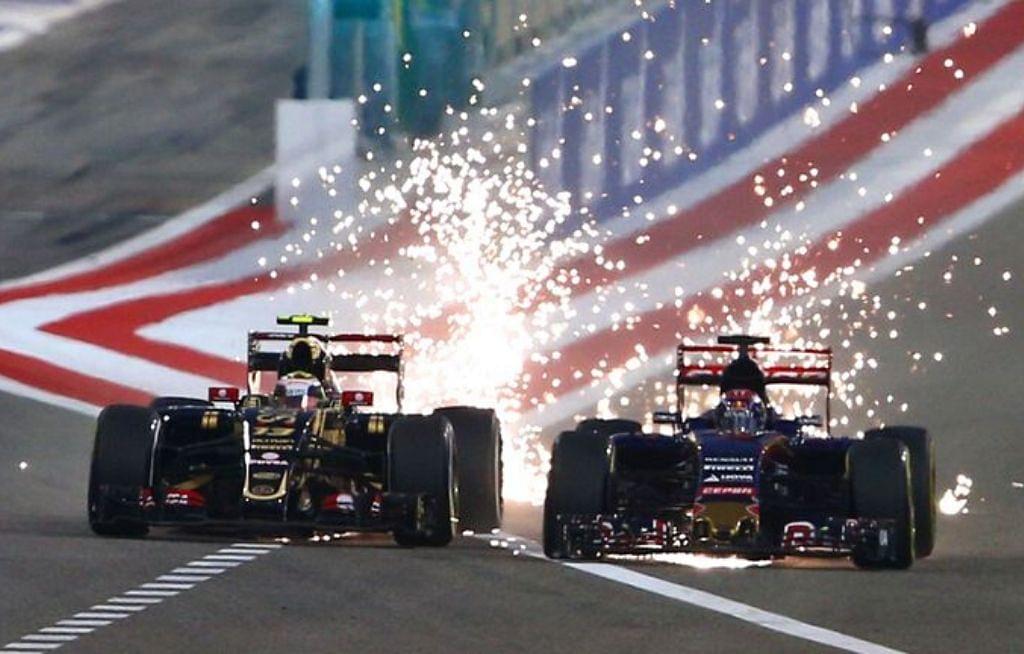Showers of sparks flying out of the F1 cars are a spectacular sight to watch, especially during night races. But it often leaves the fans wondering about how and why does it happen?
This particularly striking phenomenon is a consequence of a significant part of an F1 car. Formula 1 cars feature a titanium skid block underneath the floor.
Racing at high speed, the floor is pressed down onto the track due to aerodynamic forces. The floor then scrapes along the tarmac and propels the creation of the spark.
A perfectly-timed photograph visualizes the flow behind a modern @F1 car through a glowing shower of sparks. This in-situ PIV reveals key flow features like the strong upwash behind the car, trailing vortex pair, and (nearly) lateral expansion at ground level.#F1Tech #F1 pic.twitter.com/GsQH6rharI
— Bryson Sullivan 🇺🇲 (@NaturalParadigm) June 17, 2022
F1 cars have been sparking since the 80s
Interestingly, this phenomenon has been part of Formula 1 since the 80s. Back in those days, the teams would run their cars as low as possible to create more downforce. In turn, this low ride height would generate sparks.
However, in 1994, the FIA regulated that a 10-millimetre skid block/plank shall be installed to curb the constant lightning from the cars. If the block wore off more than 1 millimetre by the end of the race, then the driver was obliged to be disqualified.
Teams quickly found the fix against the newly imposed rule by strategically placing the pieces of metal on these planks. Cars would bottom out on them instead, allowing them to run lower ride heights without fear of being disqualified.
But it caused the spillage of large chunks of metal on the track posing the risk of tyre punctures and hazards. Thus, the FIA instructed the teams to use Titanium instead of metal, although it wears fast, it is safe.
These planks are made out of a wooden material known as Jabroc. It is a mixture of beechwood combined with veneers and resins used on each layer. These wooden planks are then placed on a titanium skid block that generates the sparks.
Do the sparks help drivers in racing?
While it is a beautiful sight to watch, for drivers the sparks are not so beneficial. It has been described as distracting for drivers.
A few years ago, after a race in Bahrain, Carlos Sainz had told the media that the sparks look great on television. But for the drivers, it is not pleasant at all.
Although, there was one driver who used to take full advantage of this phenomenon to stay in front of his rivals. A WTF1 video explaining the cause of sparks in F1 revealed that former world champion, Nigel Mansell used to find bumps on the track to generate sparks so that the drivers right behind him could be distracted.
How do sparks benefit F1 cars?
The sparks flying out of the F1 car are meant to prevent it from damage. The plank that generates the spark helps ensure the correct ride height by generating sparks.
It also helps the FIA monitor how teams implement the ground effect aerodynamics. This aerodynamic system was first introduced in the 1960s. It would help the teams gain more traction and speed by pulling the car to the ground.
Why do some circuits create more sparks?
The sparks usually happen on the straights. This is because the cars race at higher speeds on the straights and hence create more downforce.
The elevation of the tracks also plays a crucial role in the generation of more sparks. Some of the tracks that have both these features are Spa, Suzuka, Spielberg, Monaco, Imola, Zandvoort etc.
Night races in Jeddah and Abu Dhabi are also prone to more sparks. It delivers an impressive sight to the viewers.




